Expert Tips for Successfully Potty Training Your Rabbit
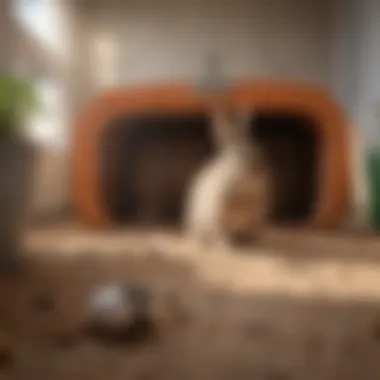
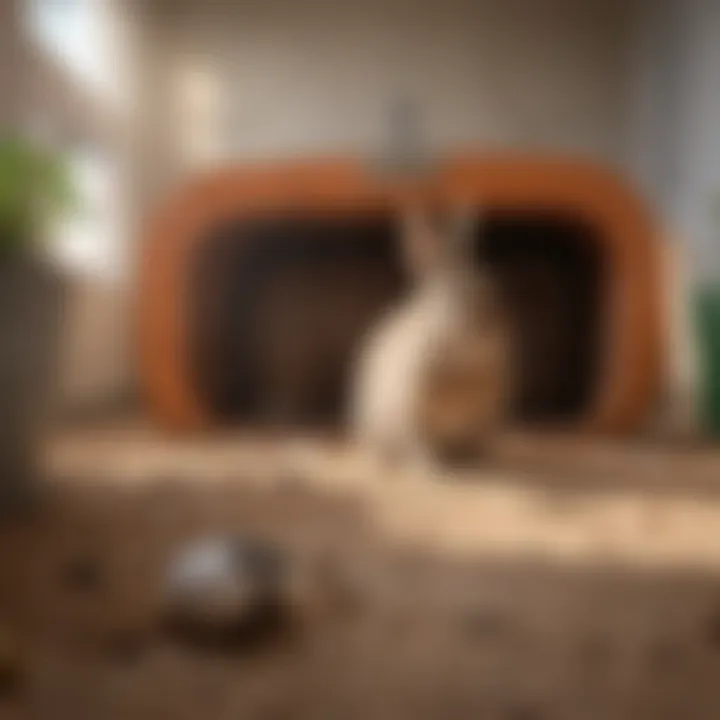
Intro
Potty training a rabbit can be a satisfying endeavor that contributes to both a healthier home environment and a better relationship with your pet. Many rabbit owners find themselves puzzled when addressing their furry companions’ bathroom habits. This task, although appearing complex, can be broken down into manageable steps.
Understanding the natural behavior of rabbits is pivotal during the process. Rabbits can be trained with consistency, patience, and a suitable approach. This guide aims to provide comprehensive techniques and insights.
Care Tips
Potty training does not solely revolve around the litter box. Providing overall care for your rabbit enables a smoother training experience. Daily routines, enclosures, hygiene maintenance, and adapting to seasonal changes contribute significantly.
Daily Care Routines
Creating a structured daily routine can facilitate a healthier living environment for your rabbit. With consistent feeding, playtime, and box cleaning, rabbits adjust more easily to training. Ensure to provide plenty of fresh hay, greens, and clean water. Keeping food and litter distinct can prevent confusion.
Cage Setup and Maintenance
A well-organized cage plays a vital role in successful potty training. The cage should be spacious, allowing room for a litter box, eating area, and a spot for resting. It is important to setup the litter box in the corner since rabbits naturally tend to choose corners for their bathroom. Use rabbit-safe litter products for maximum effectiveness.
Hygiene and Cleaning Practices
Hygiene contributes to not only the sanitation of your living space but also to the adherence of good litter training. Clean the litter box regularly. A dirty box can lead to accidents. It can also deter your rabbit from returning to the designated area for its needs.
Seasonal Care Adjustments
As seasons change, so can your rabbit’s care needs. During colder times, ensure that they are warm enough. Provide more bedding in the cage. In hotter months, maintain sufficient ventilation and cool spaces. Monitoring these shifts makes for a more comfortable space for your pet, aiding in the training effort.
Behavioral Insights
Understanding your rabbit's behavior can dramatically influence the success rate of potty training. Unveiling the intricacies of their body language and reactions provides owners with clearer insights.
Understanding Rabbit Body Language
Rabbits communicate through their body language, and recognizing their cues is necessary for effective training. Watch for signs like foot thumping, tail flicking, or flattening against the floor. These gestures indicate how they feel about their environment or training conditions.
Common Behavioral Issues and Solutions
Some rabbits might exhibit territorial or defiant behaviors that can impede the training. It can help to stay calm and not scold them. Instead, observe and implement redirection by guiding them to the litter box at consistent intervals, especially after eating or waking up.
Positive Reinforcement Techniques
Rewarding your rabbit when it successfully uses the litter box strengthens association with the behavior. Use small treats offered immediately after the action to enforce this positivity. Gradually, they learn that toilet use brings happiness.
Social Interaction Needs
As social creatures, rabbits need interaction. Spend quality time with them to nurture their affinity toward learning new habits. Engaging your rabbit also provides mental stimulation that promotes overall well-being.
Important Note: Establishing a routine and forming understanding and trust with your rabbit greatly enhances the likelihood of success in training and integration into your daily life.
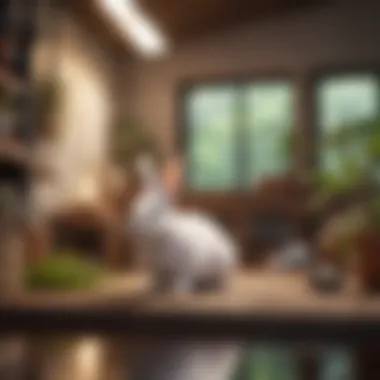

Epilogue
By encompassing these various factors into your training approach, both you and your rabbit can enjoy a more seamless and joyful experience during potty training. Remember that this process requires time and dedication. Observing your pet's behavior, providing ample supplies, and building trust are all equally important aspects to create a harmonious living arrangement.
Understanding Rabbit Behavior
Understanding rabbit behavior is crucial for effective potty training. It facilitates communication between the pet and the owner, fostering a harmonious relationship. A deep comprehension of how rabbits think and act makes it easier to prepare the environment for positive learning experiences.
Rabbits are prey animals. Their instincts are driven by survival. This means they have evolved behaviors geared towards avoiding detection by predators. When training them, it’s essential to approach with awareness of these instincts. Ensuring that their space feels safe encourages natural behavior patterns beneficial to potty training.
A further aim is to minimize stress during training. Stress can lead to unwanted behaviors, including refusing to use the litter box. When owners understand what makes their rabbits anxious, they can create a more peaceful training environment.
In summary, grasping rabbit behavior not only enhances the training process but also strengthens the bond and trust between rabbits and their owners.
The Nature of Rabbits
Rabbits are social and curious creatures. They are also quite intelligent. Their playful nature requires stimulation. Living in a communal setting, they often thrive with companionship. Training these animals is simplifying their interactions with their environment. They naturally have territories and will often choose specific areas to relieve themselves. Establishing this natural tendency as a component of the training provides assurance to the rabbit.
Rabbits rely on scents heavily. In the wild, they mark their territory with their waste. So, incorporating familiar scents into the litter box can prompt them to use it more readily. Attention must be paid to their behavior, including the places where they prefer to spend time.
Common Behaviors Related to Elimination
Rabbits display several specific behaviors correlated with elimination. These include:
- Circling: When a rabbit circles an area, it may be showing readiness to eliminate.
- Sniffing: Rabbits often sniff the ground before deciding to go. This behavior is part of searching for the right surface.
- Squatting: This is a clear sign that they are about to eliminate. Recognizing this posture lets owners react promptly.
Understanding these behaviors aids owners in guiding their rabbits to appropriate elimination areas like a litter box.
Indicators of a Potty Training Ready Rabbit
Identifying the right moment for commencing potty training is imperative. Signs which indicate readiness may include:
- Age: Ideally, rabbits aged three months and older are more capable of learning this behavior.
- Consistent Routine: If your rabbit maintains a regular schedule for elimination, this indicates their readiness for structured training.
- Absence of Fearful Responses: A rabbit that shows comfort when approached or held silently should be engaged in potty training.
Recognizing these signs maximizes the likelihood of successful potty training outcomes. By observing behaviors and developing coherent training habits in accordance with them, successful toilet habits can emerge.
Preparing for Potty Training
Before embarking on the journey of potty training your rabbit, layout a proper groundwork. The phase of preparation is crucial, as it sets the stage for a more structured approach. By ensuring a conducive environment and understanding essential supplies, you enhance the chances of success in the training process. Failing to give proper thought to this aspect can lead into complications later, such as frustrations or regression in the training process.
Choosing the Right Litter Box
Selecting the appropriate litter box is a fundamental step in training your rabbit. There are various shapes and sizes available. Nonetheless, there are key considerations that must be addressed. A low-sided box simplifies access for smaller or timid rabbits. It allows any rabbit to enter with ease. Additionally, opting for larger boxes can be advantageous for multiple rabbits or larger breeds. Ensure that the box has no sharp edges; comfort matters just as much in terms of entry and exit.
Availability and cleanliness are also paramount. An easily cleaned box can save hassle in daily maintenance. Getting a materials conducive to a cleans while maintaining a low odor is essential. It reinforces the comfort level of your rabbit in owned space. Lastly, allow enough space for the breed size of the rabbit to turn around comfortably within the litter box.
Best Litter Material for Rabbits
The type of bedding material directly impacts the success of potty training. Rabbits favor certain textures and scents which can alter acceptance of behavior while using the litter box. Paper-based litters are a safe and absorbent choice. They do limit dust and are easily found at buying spots. Another option would be aspen shavings if financially feasible. Avoid those that come with added fragrances, as they may irritate your rabbit’s sensitive nose. Whichever choice you make, confirm that it is non-toxic and does not pose health risks.

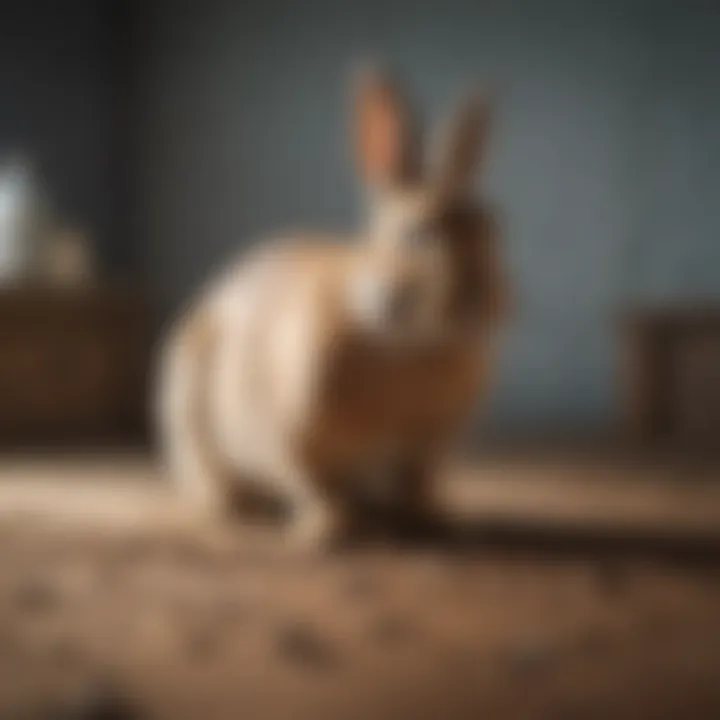
When used correctly, litters minimize odors efficiently. Discovering preferences offers better understanding of response from your rabbit, as its natural instinct may lead to improper elimination in spots outside the box, just as a note for early training phases. To maintain representability consider regular cleans at schedule to promote your rabbit’s consistency when utilizing with litter box.
Setting Up the Training Area
Creating an environment where training feels safe can dramatically change outcomes. A designated area should be quiet and less trafficked by potential overwhelm of surrounding stimuli. It encourages them to feel secure while utilizing the litter box effectively. Making use of more positive reinforcement surroundings plays an important role in overall behavior development inside that set area. Establish barrier when setting up the litter box particular from common stressful hotspots, such as food areas.
Moreover, eliminating clutter in the place minimizes chances for distractions or misunderstandings at elimination periods. By hindering options, confusion implant earlier versions most become outdated; if your rabbit knows behavior aligns with specific spots, as a result learning becomes directed and guided. Include a few familiar toys or favorite resting blankets nearby to ensure comfort but to keep them focused on appropriate behaviors.
Analyzing how accurately your rabbit interacts with its space reinforces training tasks long proven to truly generate tracking confirming their understanding..
Each step leading into potty training your rabbit deserves attention to detail. Even seemingly small factors such as sizes of litter boxes matters a great deal. Make thoughtful decisions enables steady progress while avoiding complications later in either pacing or dispensing facts all around achieving the desired end. With preparations set right, you may turn your focus smoothly on the actual training processes itself.
The Potty Training Process
Before successful potty training can begin, there is a need to establish a structure. The potty training process is paramount to ensuring a harmonious relationship between rabbit and owner. Understanding this phase involves focusing on methods that promote familiarity and trust. As a caretaker, the owner must adopt a patient and consistent approach. This commitment helps foster a conducive atmosphere for skill learning, environmental adaptation, and emotional comfort.
Introducing the Litter Box
Choosing the right moment to introduce the litter box can significantly influence training. Ideally, place the litter box in an area where the rabbit frequently eliminates. Meanwhile, make the box easily accessible. This positioning shows your rabbit you acknowledge its natural instincts, promoting positive associations. Use a size-appropriate box—none that is overly large, as it may feel overwhelming. Finally, demonstrating the use of the box can also be beneficial. Observe how your rabbit interacts with it; often, curiosity drives rabbits to explore new elements in their environment.
Reinforcing Positive Behavior
Positive reinforcement is effective in shaping your rabbit's behavior. Offering treats when the rabbit successfully uses the litter box encourages repetition of this desired action. Timing is essential—reward immediately after the successful act to associate praise effectively. Additionally, verbal affirmations, such as gentle and encouraging words, can contribute to your rabbit's understanding. Creating a pattern of rewards empowers the rabbit, reinforcing a well-behaved companion over time.
Dealing with Accidents
No matter how steady the training appears, accidents may occur. It is critical to remain calm during these moments. Scolding or displaying negative emotions can alienate the rabbit. Instead, review recent activities to identify triggers contributing to these accidents. Clean the area quickly to remove odors that may encourage repeated offenses. Utilizing enzymatic cleaners can effectively address lingering scents. Learning from these mishaps is part of training rather than a fault; they can provide insight into the rabbit’s habits.
Recognizing Patterns in Elimination
Observational skills are highly valuable during the potty training phase. Rabbits tend to establish specific patterns or routines regarding where and when they eliminate. Mapping these habits can simplify the potty training approach. Keeping a journal may help—including time and places noted—provides a clearer picture of routines. This knowledge contributes significantly to tailoring the training environment effectively, integrating litter boxes in areas pertinent to their regular eliminatory behavior. By understanding their patterns, you help shape an accommodating living space for them.
Maintaining the Training
Maintaining potty training for a rabbit is not just about the initial setup or the early stages. It is a continuous process that supports the overall wellbeing of the rabbit and makes life easier for its owner. Constant attention to training techniques, adaptability, and routine can strengthen the connection between pet and handler. Moreover, attached behavior patterns become well entrenched, minimizing any chance of backtracking.
Establishing a Routine
Creating a schedule is crucial in maintaining potty training. Rabbits, like other pets, thrive on routine. When a clear schedule is established, the rabbit learns the times it's expected to use its litter box. For example, you can take the rabbit to its designated area after meals, upon waking from naps, or after play sessions. Regularly scheduled cleanings of the litter box can also contribute to the establishment of this routine.
Furthermore, breaking down the schedule into visible increments, like using treat rewards after successful eliminations in the litter box, can enhance the routine. Consistency during training regimens depends on stick to that schedule as closely as possible. Not adhering to a routine can lead to confusion and possible accidents.
Monitoring Progress
Monitoring a rabbit’s progress in using the litter box is essential. Tracking successes and failures enables the owner to assess whether the training methods employed are effective. You might notice until what times or places the rabbit uses the litter box most often and its less favorable patterns. Taking note makes it easier to make informed adjustments.
It is beneficial to maintain a log for recording the changes, which can detail the times, places, and general health markers of the rabbit. Regular assessments also reveal thicker patterns in their behavior that may develop or evolve over time. By knowing how successfully your rabbit responds over time, you can tweak meals or playtimes, positively affecting potty habits.
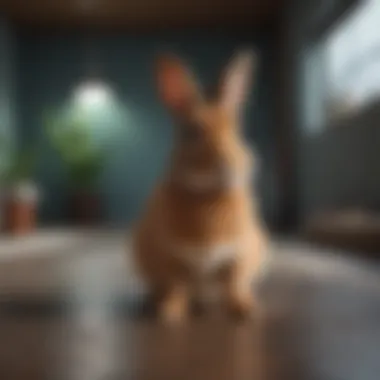
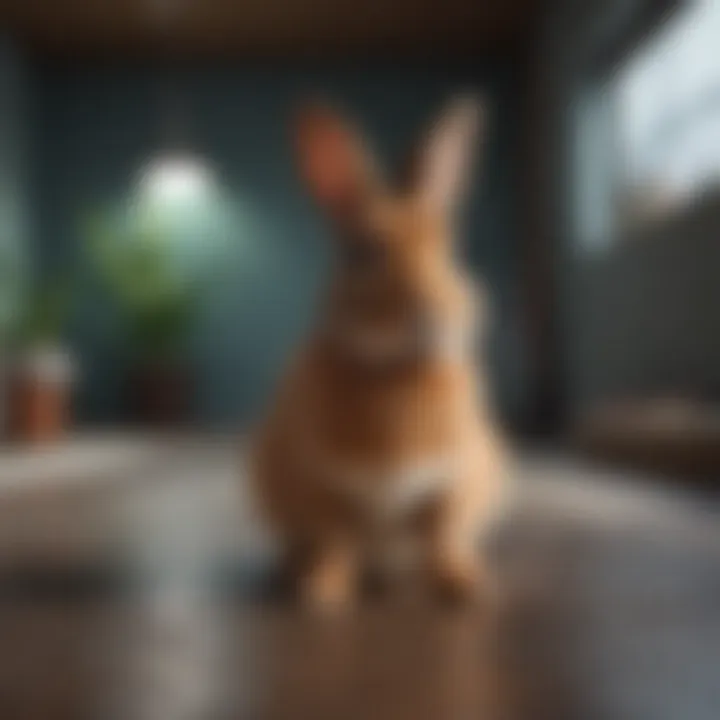
Timing is fundamental; adjustment is necessary when you notice slow progress.
When to Adjust Training Techniques
At times, the techniques used during the initial training may not remain effective. It's important to recognize when this happens. Significant changes such as a new living environment or stressors can impact a rabbit's willingness to conform to the potty training. For changes: analysis is vital. Bese steps may be necessary:
- If a rabbit stops using the puntered litter box consistently, reflecting on the reason behind that pattern is required
- Addressing environmental factors, like an uncomfortable litter box setup or distractions in their surroundings
- If progress stalls, introducing a more positive reinforcement strategy might yield results, incorporating treat rewards more prominently in the routine
Ultimately, adjusting leads to better alignment of their needs alongside established targets, reinforcing a clean pattern and a beneficial living space for both rabbit and owner.
Common Challenges and Solutions
Understanding how to successfuly potty train your rabbit means recognizing that challenges will arise. This part of the guide addresses common issues encountered during the training process. Solutions will also be suggested, helping owners overcome obstacles while ensuring a nurturing and structured environment for their pets.
Overcoming Reluctance to Use the Litter Box
Rabbits may appear hesitant to use their litter box for various reasons. One primary cause could be fear or discomfort with the litter box setup. Check the size and shape of the box. It should provide enough space for the rabbit to move comfortably.
Consider the type of litter as well. Some litters may irritate their sensitive paws. Options like pelleted paper or aspen shavings can be gentle on their feet. Another reason may be that the rabbit needs time to assimilate to the new setting.
Patience is key here. Owners can encourage the rabbit by locating the litter box in a familiar place. Use positive reinforcement, like treats or morning pets, whenever the rabbit makes an effort to use the box. Reassurance from the owner can improve the rabbit's comfort level significantly.
Managing Behavioral Issues During Training
It is not uncommon for rabbits to express unwanted behaviors during potty training. Marking territory is typical for rabbits; however, excessive urination outside the box may indicate stress or anxiety. Identifying the underlying cause is essential.
Establishment of firm and routine practices can help limit these behaviors. A established schedule will aid the rabbit in developing expectation around restroom habits. However, if anti-social behaviors persist, assessing environmental factors is crucial.
Sometimes, a lack of space can lead to inappropriate behaviors. Ensuring enough room for exercise and play can help. Additionally, introduce stimulation through toys or gentle interactions, facilitating relaxation during their training role. Regular interaction with the pet may alleviate anxiety too.
Adjusting to Change in Environment
Rabbits are creatures of habit, and changes in their environment can foster reluctance towards the litter box. New furniture placement, changes in routine, or even the presence of new pets can unsettle a rabbit, leading them to stray from established potty habits.
To counter this, create a secure space where your rabbit can feel safe, even amidst the chaos of change. Keeping their litter box in a consistent location during and after the change is critical.
Actively observe your rabbit's behavior. Gradually desensitize them to new belongings or changes through positive reinforcement methods, such as treats or encouragement.
The End
In the context of this article, concluding the insights on how to potty train a rabbit underscores the ease with which a well-organized approach can lead to a successful training outcome. It is crucial to recognize the ramifications of proper potty training, not only for cleanliness but for the overall welfare of the rabbit. Engaging with their instincts during the training enhances understanding and strengthens the bond between rabbit and owner.
Long-Term Benefits of Potty Training
Potty training offers several long-term benefits that contribute to a more harmonious home for both the rabbit and pet owner. A reliably trained rabbit provides owners with the freedom to allow them to roam in a designated area without the fear of unwanted messes. This opens up opportunities for increased interaction between rabbit and owner, enhancing social engagement.
With a trained rabbit, the task of daily cleaning becomes less burdensome. Users can focus on the enjoyment of pet ownership, rather than managing waste. Additionally, these rabbits generally experience less stress, as they learn to associate specific areas for elimination. Developing this routine contributes to a stable environment. Lastly, monetary savings can occur too by reducing the costs associated with accidents.
Creating a Clean and Comfortable Living Space for Your Rabbit
The creation of a clean and comfortableliving space for a rabbit encompasses several factors. Hygiene is crucial when housing any pet. Regular cleaning routines must be established that align with the familiarity of the litter box location. Favors obvious cleanliness oversee your pet's health.
To promote comfort, rabbits thrive in diverse habitats permitting their instincts to aid the behaviors—enrichment from engaging objects fills their necessary needs. Space consideration for other household activities can ensure the rabbit feels safe and appreciated in their surroundings.
Ultimately, incorporating healthy practices when designing a living space showcases your dedication and respect for the rabbit’s well-being. A well-maintained space, combined with understanding and training, cultivates a mutually beneficial relationship built on care and trust.















